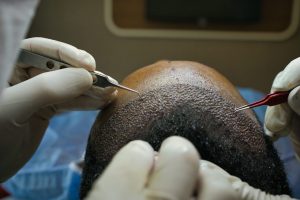WHAT IS HAIR RESTORATION SURGERY?
Hair restoration surgery procedures can be grouped into two general categories: surgical and non-surgical procedures. Surgical hair restoration procedures are widely considered the most effective options available to patients dealing with either hair loss or thinning hair, and while there is a multitude of surgical options from which patients may choose, Follicular Unit Transplants (FUT) and Follicular Unit Extractions (FUE) are both established and effective in delivering permanent results in keeping with a patient’s hair restoration goals and objectives.

These surgical procedures rely on the latest technological developments and employ the most advanced methods in order to achieve a natural-looking result for patients in need of hair restoration surgery. Surgical hair restoration procedures involve the transplantation of the patient’s own hair from a donor site located on the sides or back of the patient’s scalp. The manner in which these donor follicles are removed prior to transplantation will depend upon the specific procedure, as there are slight differences between the techniques utilized during a Follicular Unit Extraction (FUE) and a Follicular Unit Transplant (FUT).
Once the transplant grafts — which may include anywhere from one to three follicles depending on the procedure — have been harvested from the donor site, each graft will be prepared for transplantation in the recipient site (the areas in which the patient has experienced hair loss or thinning hair). The hair transplant surgeon, with input from the patient, will have already outlined a hairline and identified the specific areas within the donor site that will yield the greatest amount of coverage for the patient.
Surgical procedures for hair restorations are considered minimally invasive, but there is still some downtime that may be required following the completion of the procedure. A Follicular Unit Transplant (FUT) procedure, for example, requires the patient to avoid physical exertion for a week or two, and most doctors recommend that patients take one or two days off from work once the procedure has been completed. The post-operative care instructions differ from procedure to procedure, and it is always best to discuss any differences between procedures with a hair transplant doctor during the initial consultation process.

